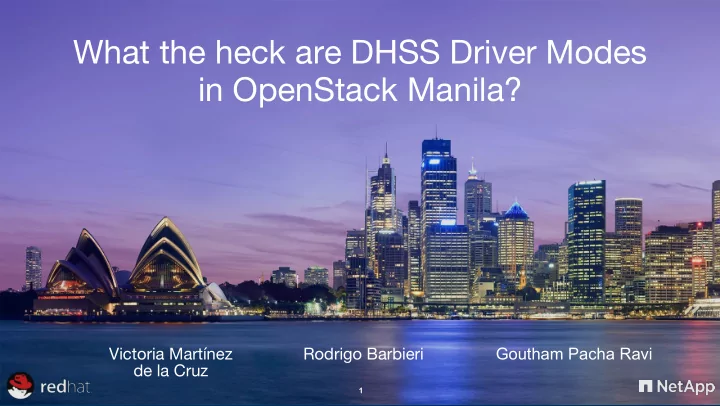

What the heck are DHSS Driver Modes in OpenStack Manila? Victoria Martínez Rodrigo Barbieri Goutham Pacha Ravi de la Cruz 1
Who we are Victoria Martínez de la Cruz Software Engineer, Red Hat Inc. OpenStack Manila contributor Rodrigo Barbieri Software Developer, NetApp Inc. OpenStack Manila core reviewer Goutham Pacha Ravi Software Developer, NetApp Inc. OpenStack Manila core reviewer 2
Why we are doing this presentation DHSS (driver_handles_share_servers) is THE MOST IMPORTANT config option in Manila • It is the first manila key concept that deployers stumble when deploying Manila • It is something deployers should know before deploying Manila, so they can set up the network correctly • It is documented, but even so, not very easy to understand • 3
Agenda Architecting NAS in a cloud • ▪ Simplest NAS deployment ▪ Introducing multi-tenancy to our simplest NAS deployment ▪ Concerns ▪ An ideal NAS architecture The OpenStack Solution • ▪ Introduction to Manila ▪ Driver modes ▪ DHSS=False deployment ▪ DHSS=True deployment Things to consider when deploying • Future enhancements • Questions • 4
Simplest NAS deployment 1) A server exports shared file systems over a network, we call it a share server 2) The share server controls access permissions to different clients mount Client A 3) Client A is authorized and mounts a share provided by the share server access denied 4) Client B is not authorized and cannot mount that same share Client B 5
Introducing Multi-tenancy Security concerns arise when providing shares to multiple tenants ▪ Data isolation - the underlying filesystem should not be shared and exports should not be visible ▪ Network isolation - there should not be connectivity to prevent spoofing and unintended access ▪ Filesystem metadata isolation - Filesystems have metadata, the universe of users for tenants is going to be different. access mount Client A denied Client X Tenant Tenant One Two access mount denied Client Y Client B 6
Scaling through automation • For single or few tenant clouds (ex: small private clouds), the desired level of isolation can be achieved by • Network segmentation outside of OpenStack (Provider Networks) • Isolated storage systems or share servers • For multi-tenant clouds (ex: large private clouds, public clouds), the number of tenants can grow over time. The tasks involved to provision secure shared file systems get harder for a cloud administrator. 7
An ideal NAS architecture • Setting up unique share servers to provide shares to different tenants • Provides data path and network isolation guarantees between tenants, even while using the same back end storage access mount denied Client A Client X Tenant Tenant One Two mount mount Client Y Client B 8
OpenStack Manila ● File share project in OpenStack ▪ Provisioning of shared filesystems to VMs ● Manila was conceived with the ideal NAS architecture in mind ● Several supported protocols ▪ NFS, CIFS, CephFS, MAPRFS, HDFS, GlusterFS ● Feature-filled ▪ Quota Control ▪ Storage Service Catalog via Share Types ▪ Access Control, Authentication Services ▪ Share Migration ▪ Grouping of shares, consistent snapshots ▪ Tenant driven Share Replication ▪ Snapshots for Cloning, Recovery and Reverting 9
Driver modes • Some back ends cannot provide automated ways to scale share servers with isolation • A flag driver_handles_share_servers (DHSS) was created to distinguish that capability • True : The driver creates multiple share servers to provide multi-tenancy isolation • False : The driver has a single share server and offer no multi-tenancy or isolation guarantees • Share drivers operate in at least one of the two possible driver modes • One instance of the driver can only operate in one driver mode 10
DHSS = False • Drivers have a single share server configured for each back end storage system • All shares are to be provided by this share server, irrespective of the tenant consuming them • Configuration complexity can be fairly low, especially networking • Multi-tenancy, data path and network isolation could be achieved outside of Manila, but may not be guaranteed • Limited by scale, ideal for private clouds with a small number of tenants 11
DHSS = False Networking using LVM and CephFS Native drivers Service Tenant Client A Client X Tenant Tenant One Two Provider Network L V Client Y Client B M 12
Let’s achieve isolation by playing with the networking Service Tenant Client A Client X Tenant Tenant One Two Provider Network Client Y Client B 13
DHSS = True • Drivers create share servers per share network • This multi-tenant focused mode guarantees isolation and provides scalability • Manila manages the lifecycle of the share server and the associated networking necessary. No administrator intervention is necessary • Supports tenant defined authentication mechanisms and ACL domains • LDAP • Active Directory • Kerberos 14
DHSS = True Networking Highlights  Client X Client A Tenant Tenant One Two Client B Client Y Backend 15
Demo of a driver configured in DHSS = True mode 16
CIFS / Active Directory in a multi-tenant cloud 17
Things to consider ▪ The driver_handles_share_servers configuration option MUST be specified for each back end stanza in manila.conf ▪ For any driver mode, plan your networking design carefully before deploying ▪ Share servers are abstracted away from end users, users can request shares to be exported on a “share-network” that they designate. In most cases, this would be the private Neutron network that tenants set up to host their VMs on. ▪ One or more security services can be associated with a share network. 18
Roadmap • Share Server HA • Improvements to the Generic Driver • Support for Dual IPv6, IPv4 networking • Support for Replication in DHSS=True driver mode • Integrating Neutron L2GW 19
Questions? Victoria Martínez de la Cruz Rodrigo Barbieri Goutham Pacha Ravi IRC: vkmc IRC: ganso IRC: gouthamr email: victoria @redhat.com email: rodrigo.barbieri2010 @gmail.com email: gouthampravi @gmail.com 20
Thank You 21
Recommend
More recommend